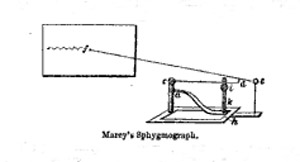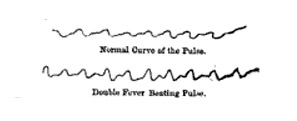
Photographing the beating of the pulse.
Journal : The Photographic News, vol. xix., no. 891.
London : Piper and Carter, October 1, 1875.
Description : pages 478-479.
Subject : Medical photography.
IN the same way as photography has secured to us many pictures of anatomical interest from dead subjects, so I have made use of the art in photographing things of physiological interest from living beings, securing certain actions in life and holding them fast in pictures. The streams of earth magnetism and the variations of the barometer and thermometer have been fixed by means of light curyes, and we are similarly in a position to depict, by means of photography, the action of the heart and the beating of the pulse.
The pulse, which serves medical men generally as a telltale of health or sickness, can be observed either by hearing, feeling, or seeing. The audible pulse is produced simply by a repetition, or carrying forward of the heart-tones, and is, at a little distauce from the heart, inaudible, except in the case of certain sickly patients, while it is well known that the action of the heart itself may be heard very perfectly through a stethoscope properly adjusted. By means of the hand, pulsations may be felt in man? parts of the body, the throbbing of the arteries being very marked. As regards the eye, too, a very simple experiment shows how well pulse action can be seen. When any one allows the hollow of one knee to rest upon the other, the upturned toe shows very visibly, by its movements, the action of the pulse ; in this way the rapidity of one's pulse may bo counted by the eye.
In the different intervals between the repeated blood-wave in the elastic tube of the artery, the walls of the latter are, to a certain extent, stretched out and contracted with every beat of the pulse. The shaking thus engendered, which we term the beating of the pulse, may, by means of a specially constructed apparatus called a sphymograph, be registered in the form of a curve. The first who essayed in this way to write down the beating of the pulse was the physiologist, Carl Vierordt, of Tübingen. He also constructed a registering apparatus for showing the rapidity with which blood moves through the body, and this he called a Hämotachometer.
A very ingenious apparatus for registering the beating of the pulse was afterwards constructed by Marey, of Paris, the invention being based upon that of Vierordt. The Marey Sphygmograph (of which we give a sketch), consists of a feel-lever in connection with a marker, which registers the pulse curve upon a moving strip of paper.

The spring, a h, lies upon the pulse at h, and is lifted in the slightest degree at every motion of the pulse. A screw, i k, is in connection with the spring h, and goes through the lever, which finds a resting-point at c, and through a screw socket at i, by means of which the screws i k can be raised or lowered at will. This lever carries at d a knife-edge, bent upwards, and touches a second lever, e f, which has its resting-point at e, and which moves with great ease up and down. The screw i k is close beside this second lever. If, now, there is the slightest movement at h, this is imparted at once to the double lever ? d, e f, and is increased very much at the end of the lever at f. The disk which carries the strip of paper in the Marey instrument is set in motion by clockwork, and travels from right to left. When the fine writing apparatus at the end of the lever e f rests upon the paper, and the spring a h is not in contact with the pulse, the result is a long line on the strip of paper ; as soon, however, as a h is brought into contact with the pulse, and the levers are set in action, there is formed at f a curved line, or, rather, series curves. Here are two examples of pulse curves as shown by the Marey instrument

The unavoidable friction which, of necessity, accompanies the pen or other writing instrument robs the curves obtained in this way of a great portion of their scientific value, and for this reason, too, the curves obtained by different instruments vary from one another. No definite conclusion can therefore be derived from the results obtained. Absolute certainty could only be ensured in the presence of an imponderable feel-lever, which could register without friction, and be without action upon the pulsating artery. Czermak believed that he had found a solution to the problem by employing light rays in lieu of the feel-lever. Rays of light are, of course, imponderable ; they write instantaneously and without friction by the aid of photography, and they are, to Czermak's thinking, also as applicable as the feel-lever, without in any way altering the natural character of the pulsations. Czermak proposes to focus the light rays by means of a convex lens, and to allow them to pass over a knob or button placed upon the artery. The shadows which this button would throw upon an enlarged scale on a wall opposite, due to the divergence of the light rays, would give, by reason of the rising and falling of the button, a marked curve upon a moving sensitive photographic plate. Czermak worked out this idea, and elaborated a so-called pulse-mirror.
This pulse-mirror is a small thin plane mirror, which is so fitted to the artery that the movements of the latter follow each other with much precision. Concentrated rays of the sun, or beams of artificial light, if strong enough, reflected at a certain angle upon this instrument on the pulse, project a picture on a wall, or screen, that may be seen by an observer or secured by means of a photographic apparatus. Every motion of the artery wall is reflected by the plane-mirror, and is repeated upon an enlarged scale. In order to secure analogous pulse-curves to those of the Vierordt Marey instrument, by this simple motion of a vertical line, Czermak has caught up the light image coming from the pulse-mirror upon a second mirror, which turns upon a vertical axis with uniform rapidity, and this second mirror it is that throws the picture upon the wall opposite. A light image of this nature moves from one end of the wall to the other in a horizontal direction at every pulsation or curve. Although Czermak believes it to be the best plan to press the pulse-mirror against the artery with the finger, he has contrived a special appliance for the purpose.
These arrangements permit the exhibition in a lecture-room, or elsewhere, to a large audience, of the action of the pulse-wave, as the image may be thrown upon a wall in full sight of the spectators. For photographic purposes, however, the modus operandi seems to us scarcely practicable, as on the one hand the reflected movements have far too large dimensions, and on the other the mechanical arrangement of the pulse-mirror, or the use of the finger, must have some injurious influence upon the formation of the curves. Moreover, Czermak, to our knowledge, has not worked out the matter from a photographic point of view, and has not made full application of the imponderable character of the light rays employed. (To be concluded)
